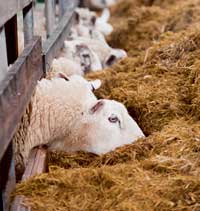Listeriosis threat to sheep

Sheep producers silage making late in the season are being warned to take particular care against listeriosis, says EBLEX beef and Sheep Scientist Liz Genever.
Caused by bacteria which thrive in soil, faeces and rotting vegetation, listeriosis can proliferate at relatively low temperatures and manifests itself in ewes drooling, with drooping faces or walking in circles as a result of abscesses in the brain.
Ewe infections are also primarily associated with high dry matter silage, says Dr Genever. “High dry matter silage’s limited fermentation can easily be insufficient to suppress bacterial multiplication. Most cases occur 4-6 weeks after poorly fermented silage is fed or where secondary fermentation of previously stable silage is permitted by failure to remove stale forage sufficiently diligently at feeding out.”
The increased demand for conserved forage feeding over the particularly cold winter could well have been responsible for the greater incidence of listeriosis encountered recently. This underlines the need for extra care in late season and big bale silage making, in particular.
“Later silage cuts tend to have higher dry matters than earlier season crops, making the exclusion of air through consolidation far more difficult. This, combined with the fact that they are invariably also lower in sugars, means a good fermentation is very much more difficult to achieve,” explains Dr Genever. Poor fermentations, in turn, mean pH’s insufficiently low to prevent bacteria – generally picked up through soil contamination – multiplying throughout the bale or clamp.
Against this background, EBLEX provides the following guidelines for minimising the risk of listeriosis at silage making:
Avoid soil contamination by setting mowers and pick-up reels sufficiently high;
Aim for 28-30% dry matter with clamped silage and 35-40% with big bales;
Consider using an inoculant additive to boost the speed of lactic acid fermentation;
Ensure both clamps and the tyres of rolling tractors are clean;
Cover clamps with two sheets of plastic and seal them diligently;
Make big bales at the highest density and consider chopping to aid consolidation; and,
Use six layers of wrap on all big bales, minimising contamination at wrapping.
Further information on listeriosis in sheep can be found at www.nadis.org.uk while a factsheet on Better Returns from Silage is available from EBLEX BRP on 0870 241 8829 or by emailing brp@eblex.org.uk
